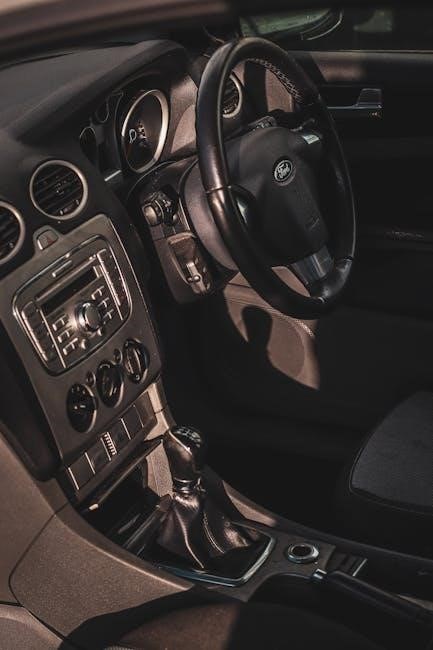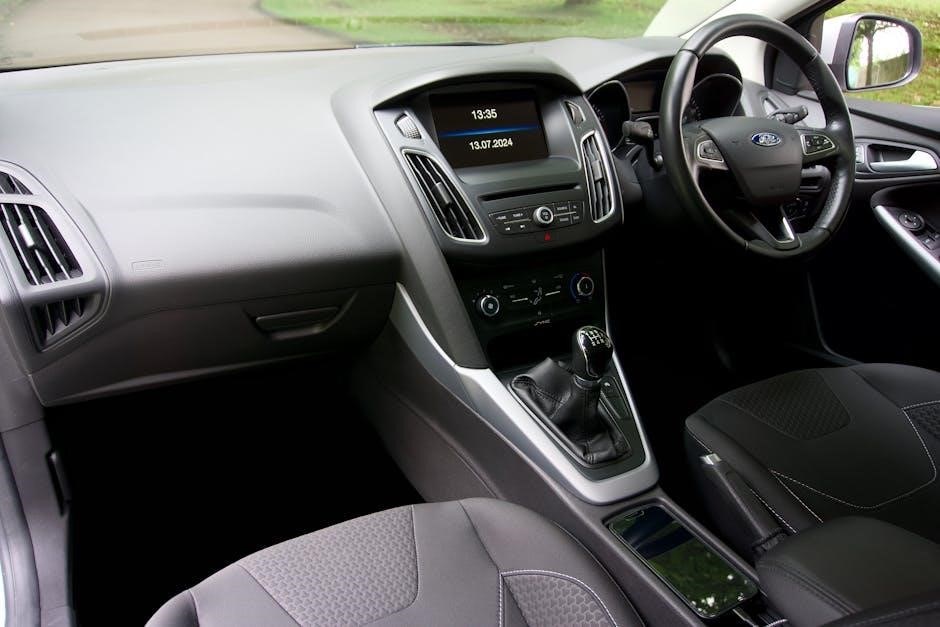Welcome to the Pit Boss Austin XL manual, your comprehensive guide to mastering this versatile wood pellet grill. Designed for precision and ease, it ensures optimal cooking experiences.
1.1 Overview of the Pit Boss Austin XL Grill

The Pit Boss Austin XL is a high-performance wood pellet grill designed for versatile cooking experiences. It combines advanced technology with durable construction, offering a temperature range of 150°F to 500°F. This grill features a spacious cooking area, making it ideal for large gatherings and family meals. The Austin XL includes a meat probe for precise temperature monitoring and a stainless steel side table with a removable serving tray for added convenience. Fueled by 100% all-natural hardwood pellets, it ensures rich, smoky flavors. Its fan-forced convection cooking system allows for even heat distribution, enabling consistent results. Whether grilling, smoking, or baking, the Austin XL delivers professional-grade performance. Its compact design and portability make it suitable for backyard cooking or outdoor adventures. With its robust features and user-friendly interface, the Pit Boss Austin XL is a versatile addition to any culinary setup.
1.2 Key Features of the Austin XL Model
The Pit Boss Austin XL stands out with its impressive array of features designed to enhance your grilling experience. It boasts a wide temperature range of 150°F to 500°F, allowing for precise control over cooking conditions. The grill is equipped with a meat probe, enabling accurate monitoring of internal temperatures for perfectly cooked dishes. A stainless steel side table with a removable serving tray provides ample space for food preparation and serving. The Austin XL operates on 100% all-natural hardwood pellets, ensuring authentic smoky flavors. Its fan-forced convection cooking system guarantees even heat distribution, while the digital control board offers intuitive temperature adjustments. The grill’s durable construction and compact design make it both long-lasting and portable. These features collectively make the Austin XL a versatile and powerful tool for achieving professional-grade results in the comfort of your backyard.
1.3 Importance of Reading the Manual
Reading the Pit Boss Austin XL manual is essential for safe and effective use of your grill. It provides critical information on assembly, startup procedures, and temperature control, ensuring optimal performance. The manual outlines safety guidelines to prevent accidents and explains how to handle wood pellets and electrical components properly. Understanding the manual helps you troubleshoot common issues, interpret error codes, and perform routine maintenance. It also covers warranty details and offers tips for achieving the best cooking results. By following the manual, you can maximize the grill’s potential, extend its lifespan, and enjoy a seamless grilling experience. Always refer to the manual before attempting any assembly or operation to ensure everything functions as intended and to maintain your safety and satisfaction.

Safety Guidelines and Precautions
Safety is crucial when using the Pit Boss Austin XL. Always follow guidelines to avoid accidents, ensure proper ventilation, and keep children away. Wear protective gear and avoid flammable materials nearby.

2.1 General Safety Instructions
Always prioritize safety when operating the Pit Boss Austin XL. Read the manual thoroughly before use to understand all precautions. Keep the grill away from flammable materials and ensure proper ventilation. Avoid exposing the unit to direct rain or moisture. Never leave the grill unattended while in operation. Wear protective gloves and eyewear when handling hot surfaces or wood pellets. Keep children and pets at a safe distance. Regularly inspect the grill for damage or wear and tear. Follow all electrical safety guidelines, ensuring the grill is plugged into a grounded outlet. Never modify the grill or use unauthorized parts. Store wood pellets in a dry, cool place. By adhering to these guidelines, you can enjoy safe and efficient cooking with your Pit Boss Austin XL.
2.2 Handling Wood Pellets Safely
Handling wood pellets for your Pit Boss Austin XL requires attention to safety to ensure optimal performance and prevent hazards. Always store pellets in a dry, cool place to maintain their quality and combustibility. Avoid exposure to moisture, as it can cause clumping and affect grill operation. Use 100% natural hardwood pellets specifically designed for pellet grills to ensure compatibility. Never handle pellets with wet hands, as this can introduce moisture. Keep pellets away from children and pets, as they may be mistaken for food. When loading pellets into the hopper, ensure the grill is turned off and cool to avoid accidental ignition. Never eat or inhale wood pellets, as they are not meant for consumption. Proper handling and storage will help maintain your grill’s efficiency and safety. Always follow the manufacturer’s guidelines for pellet usage and storage to ensure a safe and enjoyable cooking experience.
2.3 Electrical Safety Considerations
Electrical safety is crucial when operating the Pit Boss Austin XL. Always use the grill on a dedicated 120V, 20A GFCI-protected circuit to prevent overloading. Avoid using extension cords unless they are rated for outdoor use and match the grill’s power requirements. Never modify the electrical components, as this can lead to fire hazards or electrical shocks. Keep the grill and electrical connections dry to avoid short circuits. If you notice any damage to the power cord or plug, discontinue use until it is professionally repaired. For portable use, a 12V, 100W inverter can be used with your vehicle’s outlet, but ensure it is rated for the grill’s power needs. Never submerge electrical parts in water or expose them to rain. Regularly inspect all electrical components for wear and tear. Always follow the manufacturer’s guidelines for electrical safety to ensure a secure and enjoyable cooking experience with your Pit Boss Austin XL.
Assembly and Initial Setup
Begin by carefully unboxing and inventorying all parts. Follow the manual’s step-by-step guide for assembly, ensuring all components are securely fitted. After assembly, calibrate the grill according to the instructions to ensure proper function and temperature control. This initial setup is crucial for optimal performance and safety. Always refer to the manual for specific guidance tailored to the Pit Boss Austin XL model.

3.1 Unboxing and Inventory of Parts
When you receive your Pit Boss Austin XL, carefully unbox and inspect all components. Ensure the grill body, hopper, cooking chamber, and stainless steel side table are included. Check for any damage during shipping. Inventory all parts, such as the meat probe, removable serving tray, and hardware. Compare the contents with the manual’s parts list to confirm everything is accounted for. This step is crucial to ensure a smooth assembly process. If any items are missing or damaged, contact customer support immediately. Properly organizing the parts will save time during assembly. Always refer to the manual for specific guidance on identifying and preparing each component. This careful unboxing and inventory process sets the foundation for a successful setup of your Pit Boss Austin XL grill.
3.2 Step-by-Step Assembly Instructions
Assembling your Pit Boss Austin XL requires careful attention to detail. Begin by attaching the hopper to the main grill body using the provided hardware. Ensure all bolts are securely tightened. Next, install the cooking chamber and connect the necessary ductwork. Attach the stainless steel side table by aligning the brackets and tightening the screws. Mount the control panel and ensure it is properly wired. Finally, connect the meat probe and plug in the power cord. Refer to the manual for specific torque settings and wiring diagrams. Double-check all connections before powering on the grill. If unsure, consult the troubleshooting section or contact customer support. Proper assembly ensures safe and efficient operation of your Pit Boss Austin XL.
3.3 Initial Setup and Calibration
After assembly, proceed with the initial setup and calibration of your Pit Boss Austin XL. Start by plugging in the grill and turning it on. Allow the unit to run through its initial startup sequence. Next, set the temperature to 350°F and let the grill preheat for 10-15 minutes to ensure proper function. Calibrate the temperature probe by following the instructions in the manual. This step ensures accurate temperature readings. Once calibrated, test the grill by cooking at different temperatures to verify performance. Regularly check and adjust the pellet feed and auger settings as needed. Proper calibration is crucial for consistent cooking results. Refer to the manual for detailed calibration procedures and troubleshooting tips if issues arise during setup.


Operating the Pit Boss Austin XL
Operating the Pit Boss Austin XL is straightforward with its digital control system. Set desired temperatures, monitor cooking progress, and use the meat probe for precise results effortlessly.
4.1 Startup Procedure
To start your Pit Boss Austin XL, ensure it is placed on a level surface and plugged into a suitable power source. Fill the hopper with 100% all-natural hardwood pellets, ensuring the pellet level is above the minimum mark. Turn the power switch to the “ON” position and select “Setup” on the control panel. Choose “Prime Auger” to initialize the pellet feeding system. Allow the grill to preheat by setting your desired temperature using the digital control panel. The grill will automatically ignite and begin heating. Once preheated, you can select your cooking mode, such as “Smoke” or “Grill,” and adjust settings as needed. Always follow the manual’s startup procedure to ensure safe and efficient operation. Proper initialization helps maintain consistent temperatures and prevents issues during cooking. Keep children and flammable materials away during startup.
4;2 Temperature Control and Settings
The Pit Boss Austin XL offers precise temperature control, allowing you to adjust settings between 150°F and 500°F. Use the digital control panel to set your desired temperature, and the grill will automatically regulate the heat using its fan-forced convection system. For low-and-slow cooking, select the “Smoke” mode to maintain a consistent temperature. For high-heat searing, switch to “Grill” mode. The temperature can be adjusted in 5-degree increments, providing flexibility for various recipes. Ensure the lid is closed during cooking to maintain heat efficiency. The grill’s advanced temperature control system ensures even cooking, while the meat probe allows you to monitor internal food temperatures. Always preheat the grill for 10-15 minutes before cooking to achieve optimal results. Proper temperature management is key to achieving perfect smoked or grilled dishes every time.
4.3 Using the Meat Probe

The Pit Boss Austin XL comes equipped with a meat probe, designed to monitor internal food temperatures accurately. To use the probe, insert the tip into the thickest part of the meat, avoiding any fat or bone. This ensures precise temperature readings, displayed on the control panel. The probe is essential for achieving perfect doneness, whether you’re smoking brisket or grilling steak. Once the probe is in place, set your desired internal temperature using the control panel. The grill will alert you when the target temperature is reached. Always ensure the probe is clean and dry before use to maintain accuracy. For optimal results, avoid leaving the probe in the meat during preheating or when the grill is not in use. Regularly clean the probe with a soft brush or cloth to prevent residue buildup.
Maintenance and Upkeep
Regular maintenance ensures optimal performance of your Pit Boss Austin XL. Clean the grill, store wood pellets properly, and perform routine checks to maintain efficiency and longevity.
5.1 Cleaning the Grill
Regular cleaning is essential for maintaining the performance and longevity of your Pit Boss Austin XL. Start by turning off the grill and allowing it to cool completely. Use a stiff brush to remove food residue from the grates and flavor bars. Vacuum or sweep out ash and debris from the fire pot and hopper. Wipe down the exterior surfaces with a mild detergent and water. For tougher stains, a stainless steel cleaner can be used. Empty the grease bucket after each use and clean it periodically. Ensure all internal components, such as the auger and burn pot, are free from blockages. Proper cleaning prevents rust, ensures accurate temperature control, and maintains the grill’s efficiency. Always refer to the manual for specific cleaning recommendations to keep your Austin XL in prime condition.
5.2 Managing and Storing Wood Pellets
Properly managing and storing wood pellets is crucial for optimal performance of your Pit Boss Austin XL. Always use high-quality, dry hardwood pellets to ensure consistent flavor and combustion. Store pellets in a cool, dry place, away from direct sunlight and moisture. Avoid exposing them to rain or humidity, as this can cause clumping or mold. Use a sealed container or the original packaging to maintain freshness. Before loading pellets into the hopper, inspect them for any signs of moisture or damage. Old or damp pellets can clog the auger and affect temperature control. For best results, use pellets within a few months of opening. Regularly clean the hopper to remove dust and debris. Proper storage and management ensure your Austin XL operates efficiently and delivers consistent cooking results.
5.3 Regular Maintenance Tasks
Regular maintenance is essential to ensure the Pit Boss Austin XL operates efficiently and lasts for years. Start by cleaning the grill after each use, removing food residue and ash. Use a wire brush to scrub the burn pot and heat deflector, ensuring proper airflow. Check and clean the auger periodically to prevent pellet jams. Lubricate moving parts, such as the wheels and hinges, to maintain smooth operation. Inspect the RTD temperature probe for accuracy and clean it if necessary. Additionally, check the chimney and venting system for blockages to ensure proper ventilation. Replace worn-out gaskets or seals to maintain a tight seal and consistent temperatures. Finally, store the grill in a dry, protected area during off-seasons to prevent rust and damage. Regular upkeep ensures your Austin XL continues to deliver exceptional cooking performance.

Troubleshooting Common Issues
Identify and resolve common problems like temperature fluctuations or pellet jams. Refer to error codes for guidance and perform DIY repairs to ensure optimal performance and longevity.
6.1 Identifying Common Problems
Common issues with the Pit Boss Austin XL often relate to temperature fluctuations, pellet jams, or error codes. These problems can disrupt cooking sessions and require prompt attention. Temperature fluctuations may occur due to improper calibration or pellet quality. Pellet jams can happen if the hopper isn’t cleaned regularly or if damp pellets are used. Error codes, such as those indicating sensor malfunctions, should be addressed by consulting the manual. Other issues include electrical connectivity problems or faulty igniter systems. Identifying these problems early ensures smooth operation and prevents further damage. Always refer to the troubleshooting section of the manual for specific solutions and DIY repair guidance. Regular maintenance, such as cleaning the grill and hopper, can help minimize these issues. By understanding common problems, users can take proactive steps to maintain their grill’s performance and longevity.
6.2 Understanding Error Codes
The Pit Boss Austin XL may display error codes to indicate specific issues. These codes, such as E1, E2, or E3, are designed to help users identify and resolve problems quickly. E1 often relates to sensor malfunctions, while E2 may indicate ignition failures. E3 could signal a communication error between components. Understanding these codes is crucial for troubleshooting effectively. Refer to the manual for a detailed list of error codes and their meanings. Once identified, follow the recommended steps to address the issue, such as resetting the grill, cleaning sensors, or checking electrical connections. If the problem persists, contact customer support for further assistance. Regular maintenance, like cleaning the grill and ensuring proper pellet flow, can help prevent these errors. By understanding error codes, users can diagnose and fix issues efficiently, ensuring optimal performance of their Pit Boss Austin XL.
6.3 DIY Repair Solutions
Addressing common issues with your Pit Boss Austin XL can often be done with simple DIY solutions. For example, if the grill isn’t heating properly, check the pellet hopper for blockages or ensure the auger is functioning. Clean the burn pot and heat deflector regularly to maintain airflow. If the temperature fluctuates, verify that the meat probe is correctly calibrated and the lid is sealing properly. For error codes like E1 or E2, reset the grill by turning it off and on again. If the igniter isn’t lighting, inspect the igniter wire for damage or clean the igniter itself. Always refer to the manual for specific guidance. DIY repairs can save time and extend the life of your grill. However, if issues persist, contact Pit Boss customer support for professional assistance;

Mastering the Pit Boss Austin XL requires understanding its features and proper maintenance. For further assistance, refer to the official manual, troubleshooting guides, and customer support resources available online.
7.1 Key Takeaways
Understanding the Pit Boss Austin XL manual is essential for optimal performance and safety. Always follow safety guidelines, including proper handling of wood pellets and electrical precautions. Assembly requires careful unboxing and step-by-step instructions to ensure all parts are correctly fitted. Regular maintenance, such as cleaning and storing wood pellets, is crucial for longevity. Mastering temperature control and using the meat probe will enhance your cooking results. Troubleshooting common issues and understanding error codes can save time and effort. Refer to the official manual for detailed instructions and explore additional resources like customer support for further assistance. By adhering to these key takeaways, you’ll maximize your grilling experience and enjoy delicious, perfectly cooked meals every time.








































